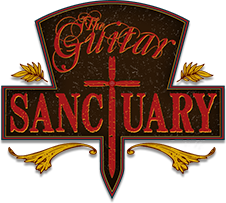One of the most confusing specs you may read or hear about a guitar is the Radius....
Let's try and break down some quick things to help you better understand A) what it is and B) why you should choose one over the other.
What it is: The Radius is a measurement of the amount of curvature of the fingerboard (and therefore the frets themselves)
What it isn't: The Radius has nothing to do with the actual shape of the neck, or the back of the carve/profile of the neck that you hold in your hand. The neck shape/contour/carve/profile and fretboard radius don't have anything to do with each other, though the combination of both affects the overall way a neck "feels" in your hands.
In a nutshell, think of it this way:
The smaller the number, the more rounded the fretboard will be, the bigger the number the flatter the fingerboard will be. IE a 7 1/4" radius is rounder than a 12" radius.
The advantage/disadvantage of each is this:
Smaller Radius (7 1/4", 9 1/2") The more rounded the radius is, the easier it is to do barre chords, as the curve of the fingerboard more naturally matches the curve of your fingers, making it easier to press down. The disadvantage to a more rounded radius is that you can't keep the action as low and still be able to do big bends, as you are essentially bending into a hill and you fret out.
Flatter Radius (10", 12", 16") The flatter the radius is, the harder it is to barre chords, as the fretboard is flatter than the normal curve of your fingers, but it is easier to keep the action lower and still be able to bend aggressively.
Warmoth also has a great graphical display of how a fretboard radius is calculated:

Some examples of standard radius's you'll find on electric guitars include 7 1/4" and 9 1/2" on most Fender guitars, 10" or 11.5" on most PRS guitars, 12" Radius on most Gibson Guitars, and things like 12" and 16" on guitars like Ibanez, ESP, etc.
Back in the 80s, people like Grover Jackson (now of GJ2 Guitars) and Warmoth Guitar Products began to pioneer a Compound Radius, which gets you the best of both worlds. The idea is that you start out with a more rounded fingerboard at the lower end of the neck where it is more comfortable for barre chords, and the fretboard gets progressively flatter as you go up so that you can still do aggressive bends for solos.
Some examples of guitars with a compound radius include those from Tom Anderson (12-14"), Suhr Guitars (9-12" or 12-16"), GJ2, Charvel/Jackson, and even folks like the Fender Custom Shop.
Here's a great video from Fender's Custom Shop talking about fretboard radius:



